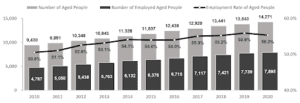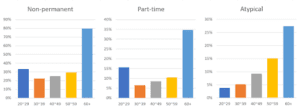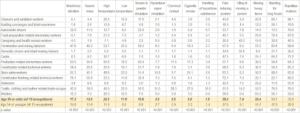-
Working After Retirement in Korea
Korea is aging rapidly with the average life expectancy extended. It became the Aging society where the proportion of people aged over 64 is 7% or higher in 2000, and will become the Super-Aged society where the proportion is 20% or higher in 2025, according to the Statistics Korea. In 2020, the number of core productive population aged between 25 and 54 will be 1.93 million less than the number in 2010. Meanwhile, the number of people aged between 55 and 59 was 279,000 in 2010, 386,000 in 2015, and keeps increasing gradually.
The rapid aging of society affects the structure of the workforce. The average age of workers increased from 34.8 in 1995 to 41.5 in 2016. The proportion of workers aged over 49 which used to be less than 25% of the workforce in 2000 is estimated to be more than 50% in 2050. In contrast, the proportion of core productive age between 25 and 49 among the whole workforce which used to be 66% is estimated to decrease to 44% in 2050.
The dominant form of wage system in Korea is the salary step system. The wage increases according to the length of service. Old workers become the major burden of labor costs in this seniority-based wage system. The wage that increases according to the work years is much higher in Korea than in other countries, which tends to force old-aged workers into early retirement. According to the Economically Active Population Survey in 2020, the average age of leaving the longest job was 49.4 in 2020. Major causes of leaving were involuntary ones, such as depression in business or forced resignation.
Only 47.1% of people age over 54 received a pension in May 2020. The average pension benefit was just 630,000 won per month, which is approximately 540 US dollars. Due to this very low income-replacement rate of pension, people cannot retire from the labor market even after the age eligible for receiving a pension. Therefore, the actual retirement age in Korea was 72 for both women and men in 2016, which was much higher than the average among the OECD countries (65.1 for men, 63.6 for women). In addition, the poverty rate in the Korean population of age 65 or higher was almost 50% in 2015, which was 4-5 times higher than the average of OECD countries[Table 1]. The immaturity of the social security system and the pension system is the main cause of this situation. There is no other way but having a poor quality of living after early retirement under this condition.
Table 1. Comparison of the Poverty Rate in Different Age Groups (2015)
* Poverty Rate is the proportion of the population with income below 50% of the median
2. Labor Market of Old-aged Workers in Korea
Those are why old people’s participation in the labor market and employment rate is very high in Korea. The proportion of people aged 55 to 64, who are defined as the Aged by the Act on Prohibition of Age Discrimination in Employment and Aged Employment Promotion, has increased from 15.4% in 2015 to 17.9% in 2020. Their employment rate also has increased from 66.0% in 2015 to 67.2% in 2020. The employment rate of people aged 50 to 74 in Korea is 62.1% in 2016, which is much higher than the average rate of OECD countries, 50.8%. The aged population has been continuously increasing. The number of people aged 55 to 79 was 14.27 million in May 2020 and 55.3% of them (7.89 million) were employed. The employment rate of these old people is still increasing except for the decline of employment due to COVID-19 in 2020[Figure 1].
Figure 1. Trends of the size of population and employment of Aged people, 2010~2020. (Source; Economically Active Population Survey in 2020)
However, the quality of jobs for aged workers is very low. Job security is also bad. Under the poor social safety net, the aged workers who retired from the main career have no other option but to continue to work in those unstable jobs. It is reflected in the statistics; the proportion of temporarily employed workers in Korea is 32.7% among workers in age 55 to 64, which is four times higher than the average of OECD countries, 7.9%. The proportion of insecure jobs in the aged workers is significantly higher than that of the younger workers in Korea. According to the statistics in August 2017, proportions of all types of insecure jobs such as non-permanent jobs, part-time jobs, and atypical employments among the workers aged over 59 were very high[Figure 2].
The average working hour of aged workers in Korea is 18.6 hours per week, which is longer than the average among OECD countries, 16.9 hours. The income of full-time aged workers in Korea is 0.91 of that of workers aged 25~54 while that is 1.10 in OECD countries. It clearly shows that aging is accompanied by a decrease in income in Korea.
Figure 2. The proportion of insecure jobs in different age groups, August 2017 (Source; Korean Statistical Information Service)
3. Safety and Health in the Major Jobs of Old-aged Workers
In 2014, Korea Occupational Safety and Health Agency, KOSHA, listed forty occupations in which many workers aged over 54 were hired, based on data from the Local Area Labour Force Survey. Then fifteen occupations with a high proportion of aged workers and bigger needs for safety and health services were selected among them based on an analysis of 3.4 million aged workers. Those fifteen occupations were (1)cleaners and sanitation workers, (2)building concierges and ticket examiners, (3)automobile drivers, (4)food preparation related elementary workers, (5)caregiving and health service workers, (6)construction and mining laborers, (7)domestic chores and infant rearing helpers, (8)cooks, (9)production related elementary workers, (10)construction related technical workers (11)store sales workers, (12)construction finishing related technical workers, (13)deliverers, (14)textile, clothing and leather related trade occupations and (15)welders. The proportions of workers who werewere exposed to usual occupational hazards in each occupation were compared between 55 or older group and the younger group based on the result of the Working Conditions Survey[Table 2]. Aged workers (≥ 55) showed a higher proportion of exposures than younger workers (<55) in all the assessed hazards including physical factors(vibration, noise, high and low temperature), dust and hazardous gas(smoke, powders, vapors, and cigarette smoke), chemicals and musculoskeletal factors(painful posture, lifting and moving a person or heavy items, standing for long hours and repetitive motions).
Table 2. Proportions of workers who are exposed to usual occupational hazards in fifteen occupations which employ many aged workers. (%)
Aged workers were exposed to more occupational hazards other than the ones in Table 2. Night work is also very frequent among aged workers. It was estimated in the Labor Conditions Survey by Employment Type in 2013 that 17.0~18.3% of aged workers (≥55), 220~300 thousand workers, were hired in night work. Emotional labor is another hazard that a considerable number of aged workers are experiencing. According to the Report on Condition of Building Concierges in Seoul by Seoul Labor Center in 2019, 19.1% of 490 concierge workers in the survey had been mistreated by the residents of the buildings.
Those hazards can affect the health of aged workers in addition to the risk of diseases due to aging. According to KOSHA’s analysis of data from the Labor conditions Survey in 2014, workers aged over 54 had a much higher prevalence rate of cardiovascular diseases than workers younger than 55(Male 3.88% Vs. 1.07%, Female 4.05% Vs. 0.74%). Occupational hazards such as night work added to aging could contribute to this elevated prevalence in aged workers. Prevalence of musculoskeletal pain in shoulder, neck, and arm (Male 44.4% Vs. 28.7%, Female 60.8% Vs. 36.1%), depression or anxiety disorders (Male 1.32% Vs. 1.14%, Female 2.43% Vs. 1.63%), and sleep disorder (Male 2.58% Vs. 2.25%, Female 4.15% Vs. 2.20%) also showed higher prevalence in aged workers than workers younger than 55. The workplace injury incidence rate in aged workers has been increasing too. Workers aged over 59 contributed 23% of all workplace injuries in 2018, which was 11%p bigger than the proportion in 2008. It seems to be due to increased exposure to risks rather than the increased number of aged workers, considering the proportion of aged workers among all workforce increased only 4.9%p during the same period.
4.Occupational Injuries of Old-aged Workers
Statistics on occupational diseases show that the approval rate for workers’ compensation usually decreases according to the increase in workers’ age. The approval rate in 2018 was mid-60% for workers in their 30s-50s, 57.8% in the 60s, and 44.4% in the 70s. Many cases of musculoskeletal disorders, the main work-related diseases, have been dismissed since they were considered as the natural consequences once any degenerative factor was found even though symptoms had developed due to work. It tends to be approved only when the workload is big enough to offset the aging-related degenerative factors. In fact, they can approve the claim regardless of degenerative factors if the workload would have affected the aggravation of the diseases. However, decisions tend to be made conservatively since there are no agreed criteria for these situations. A considerable number of cerebrovascular and cardiovascular diseases have also been dismissed due to the chronic pre-existing conditions in aged workers such as high blood pressure or diabetes despite the high workload. Defining high workload without consideration of the age can cause flaws in the assessment of workload of aged workers by ignoring the decline of physical capacity from aging. In consequence, it has been taken for granted that aged workers have a lower approval rate of workers’ compensation than non-aged workers even though they were exposed to more occupational hazards.
Yet aged workers have another fundamental problem, instability of employment. Soaring insecure jobs as shown in [Figure 2] and the high poverty rate in the old population make it extremely difficult for aged workers to file a claim for compensation for their physical or mental health problems. As a physician at an institution that conducts the special health exam for night work, I am occasionally asked by aged workers not to send the results to their employers. Though employers cannot see private information, I can empathize with them. They just want to say ‘give me a job, no matter what happens to my health.’



Comments